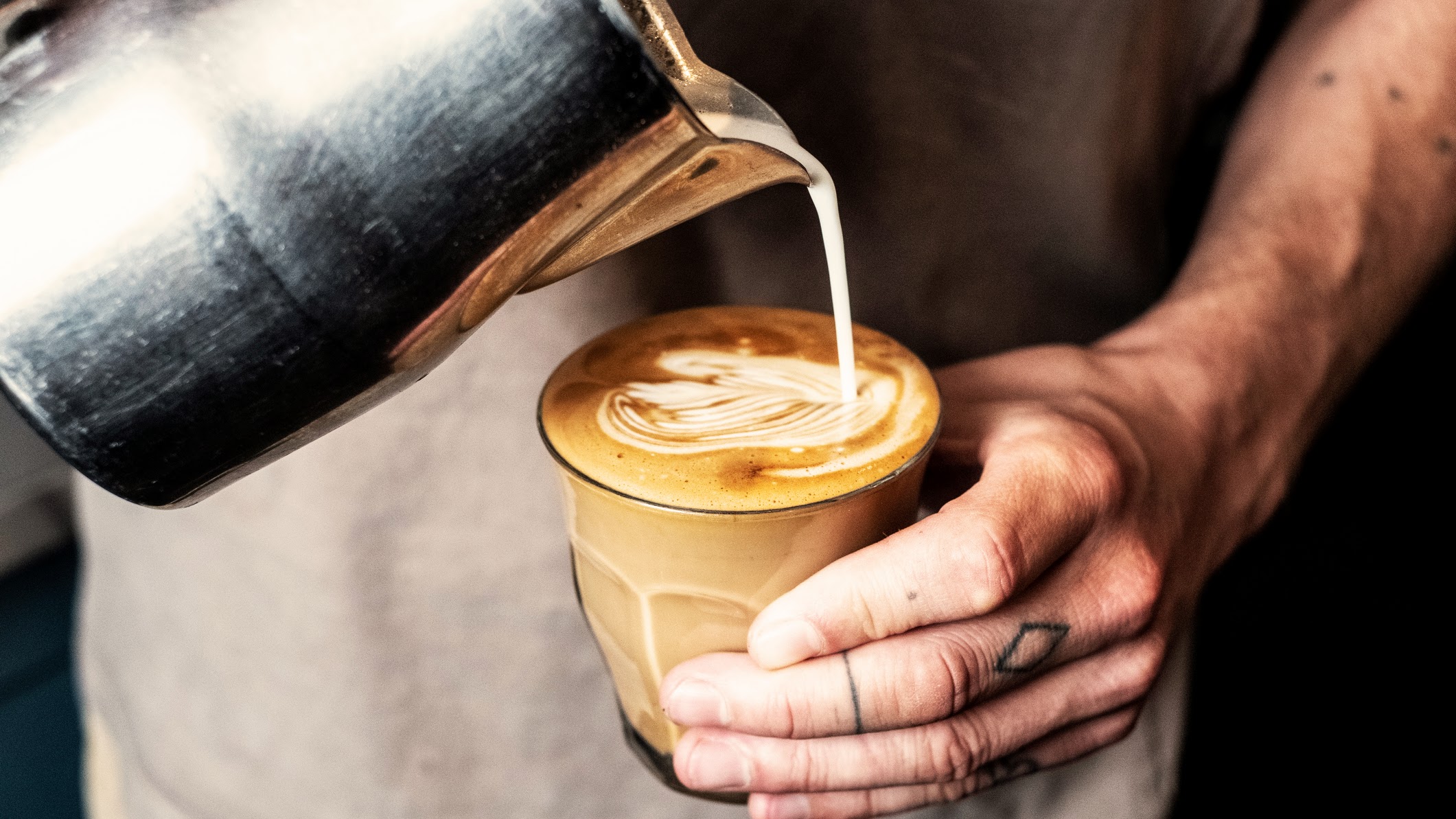French press vs AeroPress: which coffee brewing method is best?
It's a closely matched contest - but which is right for you?

Water Capacity: 32 ounce
Grind size: Coarse
Brew time: 4 minutes
You can depend on the Espro P3 French press to serve up a smooth cup of joe to start the day. It promises grit-free coffee thanks to the patented double filter that keeps stray grounds out of your drink.
It's well-suited to traditionalists who want consistent results they can rely on. It transforms coffee making into an experience, perfect for relaxed mornings with friends and family.
Pros
- Consistent performance
- Simple to use
Cons
- Faff to clean

Water Capacity: 10 oz
Grind size: Medium
Brew time: Less than a minute
The AeroPress has quickly established itself as a cult classic. The super-speedy brew time is a winner if your morning routine is on the hectic side - it takes less than a minute.
The lightweight but robust design makes it ideal for serving up coffee on the go. It's easy to pop it in your bag for a pick-me-up at work, plus it can even accompany you on camping adventures.
Pros
- Super-quick
- Portable
Cons
- Smaller serving size
Can't live without your caffeine fix? Manual coffee makers are an affordable way to enjoy your morning coffee. They take up less room than automatic coffee makers, so they are a superb choice if space is at a premium. Two of the most popular methods are the French press and the AeroPress. While both are budget-friendly, they have key differences.
The French press (aka the cafetière) is an iconic coffee maker. Legend has it was invented when a French man desperately needed a caffeine boost and improvised a rudimentary version over a fire. Despite its name, the first patents were registered in the US by Italians in 1929. It's remained popular ever since.
The AeroPress, on the other hand, is a relative newcomer, shaking up the coffee market since 2005. The inventor behind it had a history in toy-making, and that ingenuity is evident in the design. With millions sold, it's fast challenging the French press for the crown of the best coffee maker.
But how do the two coffee makers differ in design, features, performance, and taste? Which one is the best fit for you? Keep reading our French press vs AeroPress guide to find out.
French press vs Aeropress: Design
When it comes to looks, the French press and the AeroPress are at opposite ends of the spectrum. The French press has the edge in the style stakes. With its tall glass carafe, it encapsulates elegant simplicity, adding effortless chic to your breakfast table. You can also find stainless steel models that retain heat for longer, so you don't have to worry about your drink going cold. The French press is heavier and more fragile than an AeroPress, so it is best suited to home use. Glass ones, in particular, can break if mishandled.
The AeroPress, on the other hand, looks like something out of a science experiment. It appeals to a more sleek, modern aesthetic. As it's incredibly lightweight and robust, you can easily pop the AeroPress in your bag to take to work. It's perfect for busy people who struggle to find time in their morning routine for coffee at home. Its light, portable design also makes it a firm favorite among outdoorsy people, as it's durable enough to survive camping or traveling.
Serving size is another major design consideration. The AeroPress Original is single-serve. That works well if you prefer to relish your coffee all to yourself and want to avoid the faff of preparing a full cafetière.
Sign up to receive the latest news, reviews, buying guides and deals direct to your inbox
If you're making coffee to share, the French press is a better bet. You can choose from a range of sizes so you and your family or guests can savor your coffee together.
Verdict: If you're looking for timeless elegance, the French press has your name on it. It adds instant gallic chic to your breakfast table, perfect for leisurely mornings with friends and family. If, however, you're always on the go, the AeroPress is a must-have. It will be your new best friend on camping trips and outdoor adventures.
French Press vs AeroPress: Features
When it comes to features, the French press is more pared-back. It may lack bells and whistles, but it does its job well. It's all about serving up a consistent cup of coffee every time. Slight differences in preparation don't affect the final product too much. That means you don't have to worry about timing it to a tee or measuring out your coffee with precision.
When choosing a French press, look out for models like the Espro P3 with a double filter - it can reduce the chances of pesky coffee grounds making their way into your drink.
The AeroPress, on the other hand, offers endless possibilities. To begin with, you have two choices of brewing method. There's the original immersion method and the inverted one, which involves making it upside down and flipping it. While this adds an element of excitement to your morning coffee, there is a knack to it to avoid a messy mishap. Overall, the brewing method is more involved than a French press, and it does take a little physical effort to insert the cylinder.
With the AeroPress, tweaks in the brewing method can have a significant impact on the taste. That makes it perfect for experimenting with different types of beans, brewing periods, etc., to fine-tune coffee to your tastes. Plus, you can buy accessories like the flow control filter cap, which creates a stronger espresso-style drink. It's great if you're a bit of a coffee geek and want to try out different styles.
Verdict: If you crave a simple coffee-making experience without any faff, the French press is the best choice for you. By contrast, the Aeropress majors on versatility. It's perfect if you fancy yourself a coffee connoisseur and love the idea of endless experiments.

French press vs Aeropress: Performance & Taste
Small differences in the coffee brewing method have a big impact on your coffee-making experience - and the resulting cup of coffee.
Pressed for time? The AeroPress has got your back. It delivers a caffeine fix in just under a minute. It's perfect for rushed days when there's no time to stop and ideal for a quick pick-me-up at work.
The AeroPress uses a pressure-based extraction method to accelerate the process. The plunger forces water over the coffee and through the filter into your cup. The brewing process requires a little more physical effort and is less forgiving than the French Press. We recommend you opt for medium grounds with an AeroPress - the smaller surface area helps maximize the flavor, even with a short brewing time.
The French press is a more leisurely, indulgent affair than the AeroPress. It relies on the immersion method. Coffee grounds are steeped in hot water to bring out the rich flavors. It's best to allow the grounds to steep for at least 4 minutes. If you can bear to leave it a little longer, the taste intensifies. The slower extraction demands patience, though the flavorful results are worth the wait.
Differences in filtering also influence the taste. With a French press, the mesh filter allows the coffee oils to pass through into your drink. The oils carry and enhance flavor, yielding a robust, aromatic, full-bodied taste. It may be too strong for people who prefer a mellow brew. It's best to opt for coarse coffee grounds to minimize residue at the bottom of your cup.
With an AeroPress, the taste can vary wildly depending on the process. Yet overall, the addition of a paper filter results in a smooth, clean taste. That's because it stops the oils from passing through. You may sacrifice some flavor, but on the flipside, the resulting brew is less likely to have a muddled taste. Coffee enthusiasts may find it easier to pinpoint the intricacies of flavor and pick up on tasting notes like chocolate or citrus. Its more mellow taste also makes it well-suited to people who find French press coffee too acidic. Some people believe that removing coffee oils makes it a healthier brew.
Verdict: While on the surface, these are both immersion methods, there are surprising differences in the resulting taste. The right one for you boils down to personal preference. If you prefer a rich, aromatic cup of coffee every time, stick with a French press. If, on the other hand, you enjoy a more mellow flavor with clarity of taste notes, the AeroPress is the one for you.
French press vs Aeropress: Care & Maintenance
While the coffee-making experience might be laid-back, cleaning a French press can be a bit of a faff. You need to clear out the coffee grounds beneath the filter every time. The good news is that many models are dishwasher-safe, saving you a chore. Be sure to check the manual for your specific model first.
If you've been put off buying a French press because of the clean-up, the AeroPress is a game-changer. A major draw is it's super-easy to clean, thanks to the addition of paper filters. That means you don't have to bother with scraping out coffee grounds. But the trade-off is that it produces more waste. If sustainability is a concern, you can rinse and re-use the filters, though that does require more cleaning. The paper filters are also compostable. The AeroPress itself is designed to be almost indestructible, so it should last you a long time.
The French press creates minimal waste, so you can feel good that you're doing your bit for the planet. If you want to take it a step further, you can use the spent coffee grounds for several home and garden jobs, from composting the garden to scrubbing pans.
Apart from clean-up, the French press is pretty low maintenance compared to alternatives like espresso machines. To keep yours in top condition, you'll need to descale the filter to remove mineral deposits. Every couple of weeks should be sufficient for most households, though you may need to tackle it more often if you drink a lot of coffee or you live in a hard-water area. Mix a solution of half water and half vinegar and scrub the cafetière with a sponge. Be sure to rinse thoroughly afterward to avoid a vinegary undertone in your coffee.
If that sounds like too much, you'll pleased to know that AeroPress requires even less maintenance. The AeroPress website recommends you wash the rubber seal once a month to prolong its life. On occasion, it's worth washing your AeroPress in hot water and baking soda to get it squeaky clean.
Verdict: Compared to alternatives like espresso machines, the French press and the AeroPress are relatively low maintenance. If minimizing clean-up is a top priority, AeroPress is a great choice. Otherwise, a dishwasher-safe French press can save you time.
French press vs Aeropress: Price
Both the French press and the AeroPress are affordable options.
Let's take the French press first. You can enjoy your coffee for less with budget options starting at $9.99, like the Entemah French press on Amazon. In this price range, you can expect a decent model without any bells or whistles.
At the other end of the spectrum, you can splurge on a high-end French press like the Espro P7 on Amazon, which will set you back $119.95. Premium models like the Espro P7 typically benefit from double-walled insulation. This is worth the extra investment if you want to keep your coffee hot for longer. High-end models tend to be made of more durable materials, so you can be confident that your coffee maker is built to last.
Reviews
Bosch TQU60703 800 Series VeroCafe Espresso Machine review: a smart coffee maker that can do it all
Casabrews 5700Pro Espresso Machine review: an all-in-one espresso machine with a learning curve
Jura E8 review: the best-selling bean-to-cup coffee maker from the brand
De'Longhi TrueBrew Drip Coffee Maker review: truly a marvelous brewing experience
De'Longhi Eletta Explore review: a bean-to-cup coffee maker with hot and cold brew options
L’OR Barista Coffee & Espresso System review: espresso shot or cup of coffee?
The AeroPress is a brand, so there are fewer buying choices. The Original is the entry-level model and retails at just $39.95. A more recent addition to the AeroPress family is the AeroPress XL, which has the capacity for 1-6 espresso shots. It comes at a higher price tag of $69.95, though it justifies the investment if you want coffee to share.
When figuring out your budget, don't forget to factor in additional costs. The AeroPress Original comes with a generous supply of microfilters, but once they're gone, you'll need to keep replacing them. Remember, too, that you'll need to budget for coffee beans or grounds on an ongoing basis. If you opt for beans, you'll also need a good-quality grinder.
Verdict: Affordability is a big draw for both coffee makers. French presses come in a much broader range of prices than the AeroPress. Investing in a higher-end model is often worth it in the long run as it's more likely to last the test of time, though you can absolutely find budget versions. The AeroPress has a more limited price range. The Original is incredibly robust and offers great value, considering it may just last you a lifetime.
French press vs Aeropress: expert opinion
"The Aeropress and French press have a lot the same and a lot different about them. In general, a French press is a better tool for home use and brewing more than one cup at a time, and an AeroPress is great for campers and travelers who want to brew coffee easily. The AeroPress comes with a paper filter that removes all sediment, unlike the French press, where the mesh filter can let sediment pass through.”
Laila Ghambari, award-winning barista

Laila Ghambari has nearly 20 years of specialty coffee experience. She won the prestigious title of United States Barista Champion in 2014 and was an elected member of the Executive Council for the Barista Guild from 2012 to 2016.
Her expertise is in running multi unit retail operations, training and education, as
well as team and organizational leadership. This year, she founded By Laila Ghambari, her coffee business consulting company that provides simple tools every coffee shop needs to achieve operational excellence.
French press vs Aeropress: Our verdict
Choosing between an AeroPress and a French press ultimately depends on your lifestyle and personal taste.
If you're looking for consistency and old-school simplicity, a French press is the way to go. You may sacrifice portability, but if you intend to enjoy your coffee from the comfort of your own home, that's no great loss. It's perfect if you find the process of making coffee therapeutic and want to take your time. When it comes to taste, a French press suits people who prefer a robust, full-bodied flavor.
By contrast, people who are always on the go will get the most value from AeroPress. Its lightweight design combined with the speedy results makes it ideal for taking to the office or off on an outdoor adventure. It's already established itself as a favorite among campers and travelers.
While the AeroPress is a little more involved to use, true coffee geeks will
appreciate the possibilities for experimentation. It's perfect if you enjoy subtle flavors and a clean finish.
To summarize, French presses are best for home coffee drinkers who want a consistent brew. AeroPress is better if you're always on the go or like the idea of experimenting with different recipes and methods. And if you really can't decide, both options are super-affordable, so it's not out of the question for coffee lovers to have one of each.
Louise Bond is a UK-based writer and the founder of The Cove Copy. She has been published in The Guardian, Breathe, Fit & Well, Top Ten Reviews, and more. When she’s not writing, you can usually find her out in nature, whether hiking in the woods or pottering in the garden.

